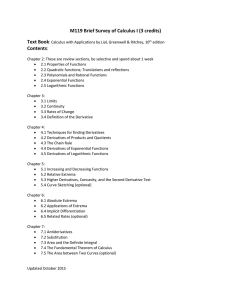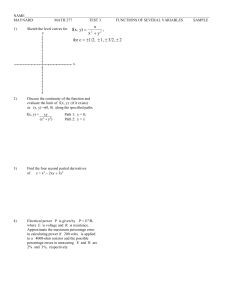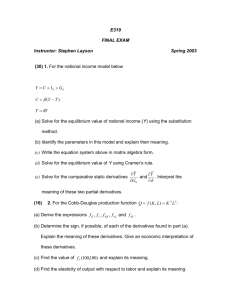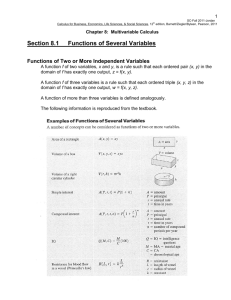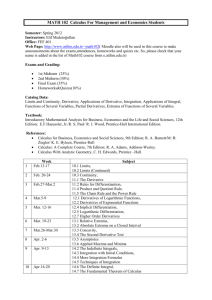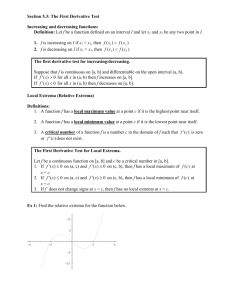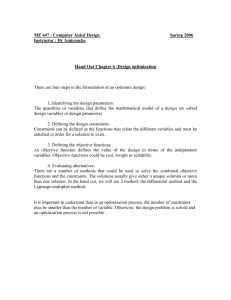PHZ 3113 Exam 1 Name:
advertisement
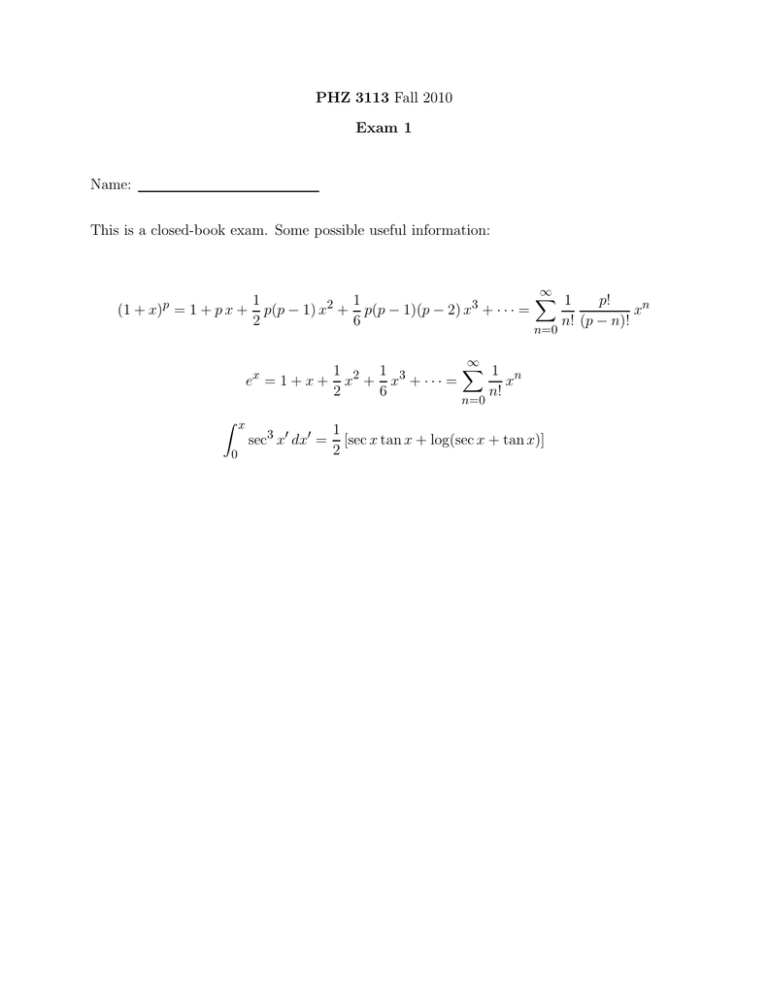
PHZ 3113 Fall 2010 Exam 1 Name: This is a closed-book exam. Some possible useful information: (1 + x)p = 1 + p x + ∞ X 1 p! 1 1 p(p − 1) x2 + p(p − 1)(p − 2) x3 + · · · = xn 2 6 n! (p − n)! n=0 ex = 1 + x + ∞ X 1 n 1 2 1 3 x + x +··· = x 2 6 n! n=0 Z x 0 sec3 x0 dx0 = 1 [sec x tan x + log(sec x + tan x)] 2 1. Let an = nn n! . Let bn = n . n! n (a) Which (if either) of the series ∞ X an , n=0 ∞ X bn converges? (Explain why or why not.) n=0 Look at an spread out in factors, an = P n n n n nn = ··· > 1 : n! n (n − 1) (n − 2) 1 an does not even pass the preliminary test. Or, look at the ratio an+1 (n + 1)n+1 /(n + 1)! (n + 1)n (n + 1) n! n + 1 n = lim → e. = = n→∞ an nn /n! nn (n + 1)! n The last step was a homework problem (with α = 1), or look at the log of the limit and apply l’Hôpital’s rule, 1 ln(1 + 1/n) (−1/n2 ) / (1 + 1/n) lim n ln(1 + 1/n) = = = → 1. n→∞ 1/n 1 + 1/n (−1/n2 ) P P an diverges; and bn correspondingly converges Since an+1 /an > 1, by the ratio test, P ( bn = 2.87985). (b) For the series in part (a) that has the worst divergence, or the slowest convergence (or P if they behave the same, pick one), does the power series cn xn (cn = an or bn ) converge for some values of x? If not, explain why; if yes, find the interval of convergence. The radius of convergence comes from an+1 xn+1 = e |x| < 1, lim n→∞ an xn and so P an xn converges for x < e−1 . 2. The logarithmic probability distribution has probabilities pn = C constant, 0 < p < 1) that a discrete random variable takes the value n. (a) What is the value of C so that ∞ X pn (where p is a n pn = 1? n=1 The sum of the pn is ∞ X C n=1 pn = C [− ln(1 − p)], n C=− 1 . ln(1 − p) This is a series that you “should” remember, but even if you don’t remember anything but the geometric series, you can get Z pX Z p ∞ ∞ X 1 n dx n−1 p = = − ln(1 − p). x dx = n 0 n=1 0 1−x n=1 P (b) Compute the average or expected value of n, h n i = n pn . (This should be one of the easier calculations on this exam). Compute the second factorial moment h n(n − 1) i. hni = ∞ X n pn = n=1 ∞ X C pn = C (p + p2 + p3 + · · ·) = n=1 h n(n − 1) i = ∞ X n(n − 1) pn = n=1 ∞ X p Cp =− . 1−p (1 − p) ln(1 − p) C (n − 1)pn n=1 = C (p2 + 2p3 + 3p4 · · ·) = Cp2 d 1 p2 =− . dp 1 − p (1 − p)2 ln(1 − p) (c) The generating function G(z) is defined as G(z) = ∞ X k=1 mic distribution. pk z k . Find G(z) for the logarith- This is the same sum as in (a), with argument pz instead of p, G(z) = ∞ X k=1 pk z k = ∞ X k=1 C 1 ln(1 − pz) (pz)k = . k ln(1 − p) dn G(z) (d) Show in general that pn is related to . Show that in general the moments dz n z=0 h n i, h n(n − 1) i are related to derivatives of G(z) evaluated at z = 1. Use your G(z)to find the moments computed in part (b). Evaluated at z = 0, the only nonzero term in n derivatives applied to the sum that defines G(z) has k = n: for those terms with k < n, dn /dz n vanishes (six derivatives of x3 vanishes); and terms with k > n have factors z n−k → 0. Thus, dn G(z) = n! pn . n dz z=0 From the definition, d2 dz 2 ∞ ∞ X X d n−1 = pn n z = n pn = h n i . G(z) dz z=1 n=1 n=1 z=1 ∞ ∞ X X n−2 G(z) = pn n(n − 1) z = n(n − 1) pn = h n(n − 1) i . z=1 n=1 z=1 n=1 (This clearly generalizes to “factorial moments” of any order.) Applied for G(z) = ln(1 − pz) , ln(1 − p) dG 1 −p hni = = , dz z=1 ln(1 − p) (1 − p) d2 G 1 −p2 . h n(n − 1) i = = dz 2 z=1 ln(1 − p) (1 − p)2 (3 + x2 ) sinh x − 3x cosh x is a modified spherical Bessel function. x3 How does i(x) behave for small x? (Find at least the first nontrivial term of an expansion of i(x) for x near 0). How does i(x) behave for large x? Sketch a plot of i(x). 3. The function i(x) = For small x, expansions of sinh x and cosh x give 1 x5 + · · ·) − 3x(1 + 1 x2 + 1 x4 + · · ·) (3 + x2 )(x + 16 x3 + 120 2 24 i(x) ≈ 3 x 1 x5 + · · ·) + (x3 + 1 x5 + · · ·) − (3x + 3 x3 + 1 x5 + · · ·) (3x + 12 x3 + 40 120 2 8 = x3 1 + 1 − 1 ) x2 + · · · = 1 x2 + · · · . = ( 40 120 8 15 For large x, the factor x2 dominates the numerator, and i(x) ≈ sinh x ex 3 ≈ 1− . x 2x x 4. The (volume) thermal expansion coefficient α is 1 ∂v α= . v ∂T p (a) An ideal gas has equation of state pv = RT . Compute α for an ideal gas. α= 1 ∂v 1 ∂ RT R 1 = = = . v ∂T v ∂v p pv T pv B (b) The virial equation of state is = 1 + , where B is constant (the virial constant). RT v Compute the thermal expansion coefficient α for a virial gas. For positive B, is α larger or smaller than for an ideal gas? Write v= then ∂v = ∂T ∂v 1+ ∂T and α= RT B 1+ ; p v R B RT B ∂v 1+ − , p v p v 2 ∂T RT B R B v = 1+ = , 2 p v T pv 1 (1 + B/v ) 1 1 = . 2 T (1 + RT B/pv ) T (1 + 2B/v) For B > 0, this is smaller than for the ideal gas. Or, write T = pv/R , 1 + B/v (p/R)(1 + 2B/v) ∂v −1 ∂T p/R (pv/R)(B/v 2 ) = = . = + ∂v 1 + B/v ∂T (1 + B/v)2 (1 + B/v)2 This leads to the same result. 5. Use the method of Lagrange multipliers to find the point on the circle x2 + y 2 = 1 that is closest to the point (1, 34 ). The squared distance is d2 = (x − 1)2 + (y − 34 )2 , the constraint is φ = x2 + y 2 − 1 = 0, and the method of Lagrange multipliers say find extrema of 3 F = (x − 1)2 + (y − )2 + λ(x2 + y 2 − 1). 4 Extrema are where the derivatives vanish: ∂F = 2(x − 1) + 2λx = 0, ∂x ∂F = 2(y − 34 ) + 2λy = 0, ∂y ∂F = x2 + y 2 − 1 = 0 ∂λ The first two of these say x= 1 , 1+λ y= 3/4 , 1+λ and in the third these give 1 9 25 1 1+ = = 1, 2 2 16 (1 + λ) (1 + λ) 16 1 4 =± . (1 + λ) 5 This then gives the positions of the extrema 4 x=± , 5 3 y=± . 5 Clearly, + is the closest, − is the furthest. A plot of the geometry appears at the end. Bonus: use the method of Lagrange multipliers to find the point on the circle x2 + y 2 = 1 that is closest to the line 3x + 4y = 6. This time we need to find a point (x, y) on the circle and also another point, call it (x0 , y 0 ), on the line, F = (x − x0 )2 + (y − y 0 )2 + λ1 (x2 + y 2 − 1) + λ2 (3x0 + 4y 0 − 6). The extrema occur at ∂F = 2(x − x0 ) + 2λ1 x = 0, ∂x ∂F = 2(y − y 0 ) + 2λ1 y = 0, ∂y ∂F = 2(x0 − x) + 3λ2 = 0, ∂x0 ∂F = 2(y 0 − y) + 4λ2 = 0, ∂y 0 ∂F = x2 + y 2 − 1 = 0, ∂λ1 ∂F = 3x0 + 4y 0 − 6 = 0. ∂λ2 This is six equations in six unknowns. The middle pair can be solved for x − x0 = 3λ2 , 2 y − y 0 = 2λ2 ; with this information the first pair give x=− 3λ2 , 2λ1 y=− 2λ2 ; λ1 and in turn the fifth equation gives x2 + y 2 = 9λ22 4λ22 25λ22 + = = 1, 4λ21 λ21 4λ21 λ2 2 =± . λ1 5 Thus, 3 4 x=± , y=± . 5 5 Once again, + is the nearest, − is the furthest. This works as long as λ1 6= 0; if λ1 = 0, then x = x0 , y = y 0 , λ2 = 0, and x, y must solve both of x2 + y 2 = 1, but this pair has only complex solutions. 3x + 4y = 6, The blue points are at extremal distance (nearest and furthest) from the point (1, 34 ), which happens to be on the line in the Bonus. The red points extremize distance from the line to the circle.
